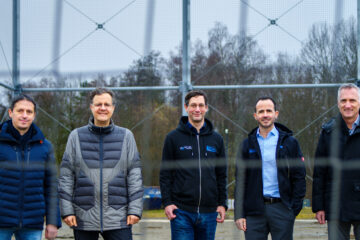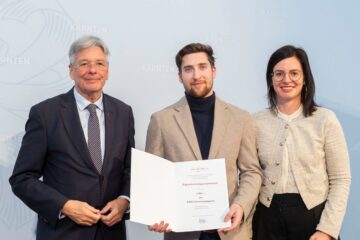
Wireless communications is essential for many applications with commercial drones. Omid Semiari interviewed Christian Bettstetter about this exciting topic at the interface of communications and robotics for the latest IEEE ComSoc TCCN newsletter.
To start, could you please explain why “communications” matter for unmanned aerial vehicles (UAVs) and what are typical applications in which UAVs need to communicate? (OS)
CB: Small commercial UAVs are used in various fields, including aerial monitoring in industry and agriculture, support for first responders, and delivery of goods. Wireless communications is essential in many applications if information sensed by a UAV must be processed on the ground. For example, consider UAVs that perform live streaming of aerial videos to support rescue personnel. Communication is also essential in the other direction for steering a UAV during flight. Last but not least, multiple UAVs may coordinate themselves using ad hoc communications without involving any ground station.
What are the main networking challenges to provide connectivity for UAVs as wireless users?
Off-the-shelf equipment is not made for communication with aerial devices. Using a standard WiFi access point on the ground and Wifi transceivers on a flying UAV yields data rates and radio ranges that are lower than expected, partly due to the antenna characteristics. Another issue is that operation in unlicensed bands might be too vulnerable for mission-critical UAV communications, which leads to a demand for frequency bands dedicated to UAVs. Also cellular networks are currently not designed for flying devices: various problems related to cell selection, handover, and interference occur and need to be solved.
Could you please comment on service requirements (e.g., data rate, latency, etc.) for UAV communications?
The communication requirements strongly depend on the application. We are currently working on a very demanding scenario in which multiple, collaborating UAVs explore an unknown environment but their control and navigation is purely based on cameras and other local sensor data without any GPS. Offloading the computation from the UAVs to a ground computer would require 100 to 500 Mbit/s per UAV in the uplink. The latency requirements are also strict but not fully understood yet, partly because it is still unclear where to process which information.
Do you see UAVs to serve as aerial base stations in future wireless networks (please elaborate on challenges such as backhaul support, power, reliability, etc.)? When do you expect them to be commercially available and/or deployed?
There are mobile mini base stations that can be transported and operated by UAVs in the air as well as on the ground, which is useful in case of disasters when ground infrastructure is no longer available. Other than such emergency scenarios, I am skeptical about UAVs serving as base stations. In my research, I utilize UAVs always as mobiles or relays.
Where do you position the fifth-generation (5G) system as an enabler for wireless UAV-based applications? What are the enabling techniques that can be borrowed in UAV communications?
5G promises high data rates and very low latencies, which are both important for many UAV applications. Beyond this, mobile edge computing will play an important role, as computations and data fusion from multiple UAVs can by offloaded to the edge with low latency.
Could you please introduce some of your most recent projects and research results related to UAV communications? (Please explain the key idea and interesting findings)
Our work with UAV systems started more than ten years ago with the development of a prototype for aerial imaging to assist rescue teams. UAVs fly over specified areas, take images, and provide an accurate and up-to-date overview picture of the environment. This task required flight path planning, communication of images, and image stitching (Ad Hoc Networks, 01/2018). For example, we proposed an antenna extension to 802.11 transceivers to be used as aerial devices and characterized the path loss and fading along with some performance measurements (IEEE INFOCOM 2013). We have gained a lot of hands-on experience over the years, paving the way for further experimental research.
Most of my UAV projects are interdisciplinary, involving colleagues from control engineering, computer vision, multimedia and wireless communications, and artificial intelligence. An ongoing project develops a system of UAVs flying in a forest to automatically estimate ecological and economic factors of this forest. Another project integrates and connects UAVs to 4G+ and later 5G networks in collaboration with T-Mobile. Besides such applied projects, I work on fundamental issues in robot swarms, for example, on joint synchronization and distributed coordination.
Beyond your own work, are there any resources that you would like to recommend, especially to those who are new in this field?
I’m convinced that research on UAV networks should involve experimental work. In this context, I follow the work of David Gesbert (EURECOM, ERC grant PERFUME), who develops e.g. self-positioning aerial relays. Petar Popovski (Aalborg, ERC grant WILLOW), who is an expert in ultra-reliable and low latency wireless communications, also gained interest in UAV communications. Some other researchers that come to my mind are Timothy X Brown (CMU), Raj Jain (WUSTL), Tommaso Melodia (Northeastern), Yasamin Mostofi (UCSB), Enrico Natalizio (Compiègne), Sofie Pollin (Leuven), Walid Saad (VT), Luca Sanguinetti (Pisa), Halim Yanikomeroglu (Carleton), Christian Wietfeld (Dortmund), Rui Zhang (Singapore), and their team members.
Newcomers should read tutorial articles on UAV communications and networking: the ones by İlker Bekmezci et al. (2013), Lav Gupta et al. (2015), Yong Zeng et al. (2016 and 2018), Samira Hayat et al. from my group (2016), and Mohammad Mozaffari et al. (2018). There is also a book “UAV Networks and Communications” edited by Kamesh Namuduri and others.
If you want to do experimental research, you should become familiar with the Robot Operating System (ROS), a UAV hardware platform suited for your objectives, and the legal and safety issues related to your work.
What are the most important open problems and future research directions towards seamless UAV communications?
Some applications require UAVs to be integrated into cellular networks due to their wide-area coverage. Such integration will only work if base stations have a different radio coverage than today, i.e., the design and tilting of antennas or sectorization needs to be adapted for ground-air communications. This should ideally be done in a way that ground devices do not suffer from the new „aerial devices,“ which will require a special radio resource, interference, and handover management.
An open issue is that many UAV applications require more data in the uplink than in the downlink — in particular, videos and images — while current cellular networks are designed in the opposite way, they support more data in the downlink.
Another important issue is the tradeoff between communications and computation in the context of multi-UAV systems with delay constraints. It addresses the question: Which data should be processed locally and which data should be communicated to whom and when?
About the person

Christian Bettstetter is professor and head of the Institute of Networked and Embedded Systems at the University of Klagenfurt, Austria, and founding scientific director of Lakeside Labs GmbH, a research and innovation company. He holds a Dr.-Ing. degree (summa cum laude) in electrical and information engineering from Technische Universität München, Munich, Germany. His research contributions are in wireless and self-organizing systems with applications in telecommunications and robotics. In 2008, he became interested in multi-drone systems and since then has been working on aspects of communication, coordination, and path planning. He is a core faculty member in the Karl Popper school on networked autonomous aerial vehicles.
This interview was originally published in the Newsletter of the Technical Committee on Cognitive Networks (TCCN) in the IEEE Communications Society (ComSoc) (Vol. 4, No. 2, December 2018). Posted here with kind permission. Feature photo by Adobe Stock. Portrait by D. Waschnig.




